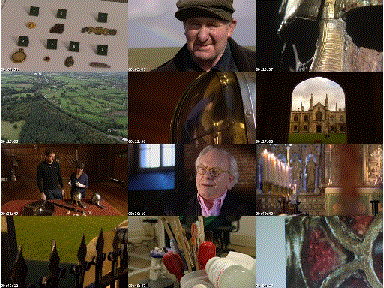The Portal to the Language of the Anglo-Saxons
The Nerthus Project - Smashing Success or Failing Flop?
October 2013
BBC to broadcast brand-new documentary on Staffordshire Gold Hoard
A new BBC2 documentary on the Anglo-Saxon treasure found in Staffordshire in 2009 will be broadcast this January. It narrates the discovery of the hoard, embeds the find in its historical context, speculates about reasons behind the burial, and points out the relevance of the treasure for our understanding of Anglo-Saxon culture. |  Saxon Hoard: Golden Discovery |
When Terry Herbert scans a lonely field near Tamworth, Staffordshire with his hobby metal detector in July 2009, he stumbles across the largest hoard of Anglo-Saxon gold and silver metalwork ever found. The multi-million pound discovery consists of 1500 items of martial art, and offers a window into England’s distant past. “The metalwork equivalent of finding a new Lindisfarne Gospels or Book of Kells," judged Leslie Webster, former keeper of the prehistory department at the British Museum.
The owner of the land, farmer Fred Johnson, was at first reluctant to let Terry Herbert search his field for metal objects, but eventually gave him permission, highly sceptical that the 55-year-old man would find anything but rubbish and dust. "He came in very excited and said I have found a Saxon hoard. It's better than winning the lottery. I told him not to be so bloody daft," Fred Johnson remembered. The treasure turned out to contain more than 5kg of gold, 2.5kg of silver and to have an estimated value of more than £3m.
The hoard was buried in the 7th or 8th century, at the time of the height of the Kingdom of Mercia. While Bede’s The Ecclesiastical History of the English People elucidates historical events pertaining to the Kingdom of Northumbria and the Anglo-Saxon Chronicle relates the history of medieval Southern England, the lack of significant literary or archaeological finds from Mercia justifies the stereotypical description of this period as part of the ‘Dark Ages.’ The hoard could now help to finally shed some light on those mysterious Mercians, their way of life and culture.
What does the hoard tell us about the Christian conversion of Mercia? Does the Latin bible quote on one of the gold strips show that Mercia had already been a Christian kingdom in the 8th century? Surge domine et disepentur inimici tui et fugent qui oderunt te a facie tua, ‘Rise up O Lord, and may thy enemies be dispersed and those who hate thee be driven from thy face.’ Do the misspellings, like fugent for fugiant, indicate unfamiliarity with the new faith? Is the treasure really more indicative of a religious transitional stage, with pagan and Christian symbols side by side, an instance of religious “bet hedging”? Or had Mercia still resisted all attempts at missionary work by the time the hoard was buried so that the presence of Christian art in it is purely accidental?
Why was the hoard buried in the first place? Did an Anglo-Saxon warrior bury it out of fear, hastily? Did the prospect of raids, political turmoil or persecution lead him to hide his valuable possessions? Was the hoard buried within sight of Watling Street, a major ancient trackway in England, so that it could be retrieved later? Or was the treasure a funerary object of a pagan burial ceremony for a powerful warlord, as described in the poem Beowulf? Would that explain why the hoard consists largely of weapon fittings and includes no feminine objects?
|
Forleton eorla gestreon eorðan healdan (Beowulf, lines 3166-9) |
The warriors left that treasure, for the earth to hold |
And where did all the gold come from? Is the treasure a token of successful trade routes reaching as far as Afghanistan and Sri Lanka? Was the treasure amassed by Mercian raiders and plunderers, grabbing the gold as spoils of war? Or did subdued peoples pay the precious metals as tribute to the king of Mercia? Are so many objects bent and twisted because they were ripped of the weaponry of fallen soldiers and chopped off enemy standards after a bloody battle? Or was the gold a gift to a trusty soldier from a benevolent chieftain, as told in Beowulf?
|
Dyde him of healse hring gyldenne (Beowulf, lines 2809-12) |
He unfastened from his neck, his golden necklace |
It will take many decades before scientists and scholars of Anglo-Saxon have evaluated the entire hoard and turn some of the speculation into facts. But in the meantime, there is a new sixty-minute documentary to be looking forward to that is bound to offer some exciting and insightful ideas about the above questions and many more.
- Find more OE news at www.oenewsletter.org
- Watch "Saxon Hoard: A Golden Discovery" in the OE Media Section
- Related links:
- Official Staffordshire Hoard website http://www.staffordshirehoard.org.uk/
- National Geographic report on Staffordshire Hoard
- BBC News on the Staffordshire Hoard
- The Guardian News on the discovery of the Staffordshire treasure
- BBC2 "Saxon Hoard: A Golden Discovery" website